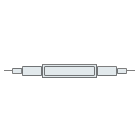Fiber Optic Tech
The Power of Optical Switches in Modern Applications
In today’s hyper-connected world, optical switches are the unsung heroes driving seamless, high-speed communication and innovation across industries. From telecommunications to medical diagnostics, these cutting-edge devices enable precise control of light signals, ensuring efficiency, reliability, and scalability. Let’s explore the diverse types of optical switches and their transformative applications.
What Are Optical Switches?
Optical switches are devices that selectively route optical signals from one channel to another without converting them to electrical signals. This capability ensures minimal signal loss, high-speed performance, and unparalleled reliability, making them essential in fiber-optic networks and beyond.
Each type of optical switch is uniquely suited to specific use cases, delivering tailored solutions for industries ranging from telecom to scientific research.
1. Relay Optical Switch
How It Works: Uses mechanical relays to physically redirect optical signals, offering low insertion loss and high reliability.
Applications:
Telecommunications: Ideal for network redundancy and fault protection, ensuring uninterrupted connectivity.
Test and Measurement: Used in optical test equipment to switch between multiple fiber channels for diagnostics.
Why Choose It?--- Cost-effective and robust for applications requiring stable, long-term performance.
2. Motor Optical Switch
How It Works: Employs a motor-driven mechanism to align optical paths, enabling precise switching in multi-channel systems.
Applications:
Data Centers: Facilitates dynamic reconfiguration of optical networks for "" balancing.
Industrial Automation: Supports optical sensing in manufacturing for real-time monitoring.
Why Choose It?--- High durability and suitability for high-channel-count systems.
3. MEMS 1xN / MxN Optical Switch
How It Works: Micro-Electro-Mechanical Systems (MEMS) use tiny mirrors to redirect light, offering compact size and fast switching.
Applications:
Optical Cross-Connects: Enables flexible routing in large-scale telecom networks
WDM Systems: Supports wavelength division multiplexing for high-capacity data transmission.
Why Choose It?--- Scalable, compact, and energy-efficient for next-gen networks.
4. Magneto-Optical Switch
How It Works: Utilizes the magneto-optic effect to control light polarization, enabling rapid switching without moving parts.
Applications:
High-Speed Networks: Perfect for ultra-fast signal routing in 5G and beyond.
Scientific Research: Used in laser-based experiments requiring precise light control.
Why Choose It?---High-speed, non-mechanical design for minimal wear and tear.
5. PM Optical Switch (Polarization-Maintaining)
How It Works: Maintains the polarization state of light, ensuring signal integrity in specialized applications.
Applications:
Fiber Sensing: Critical for distributed sensing in oil/gas pipelines and structural health monitoring.
Quantum Communications: Supports secure data transmission in quantum networks.
Why Choose It?--- Ensures high-fidelity signal transmission for polarization-sensitive systems.
6. Matrix MxN Optical Switch
How It Works: Provides flexible, non-blocking switching between multiple inputs and outputs, ideal for complex networks.
Applications:
Metro and Core Networks: Enables dynamic reconfiguration in large-scale fiber networks.
Broadcast Systems: Supports optical signal distribution in media and entertainment.
Why Choose It?--- Offers unmatched flexibility for multi-port connectivity.
7. Wavelength Selective Switch(WSS)
How It Works: Selectively routes specific wavelengths, enabling dynamic bandwidth al in optical networks.
Applications:
ROADM Systems: Powers Reconfigurable Optical Add-Drop Multiplexers for flexible network management.
Data Center Interconnects: Optimizes bandwidth for cloud computing and hyperscale data centers.
Why Choose It--- Maximizes network efficiency and scalability.
Why Optical Switches Matter
Optical switches are the backbone of modern communication, enabling:
High-Speed Data Transmission: Support for 5G, cloud computing, and IoT with minimal latency.
Energy Efficiency: Reduced power consumption compared to electrical switches.
Scalability: Seamless integration into growing networks, from small enterprises to global telecom giants.
Reliability: Robust designs ensure long-term performance in mission-critical applications.
Industry Applications
Telecommunications: Optical switches power fiber-optic networks, ensuring reliable global connectivity.
Data Centers: Enable dynamic traffic management for cloud services and AI work""s.
Healthcare: Support advanced imaging and diagnostics with precise optical control.
Defense and Aerospace: Facilitate secure, high-speed communication in rugged environments.
Research and Development: Drive innovation in photonics, quantum computing, and optical sensing.
Why Choose Our Optical Switches?
Our portfolio of optical switches—ranging from relay and motor-driven to advanced MEMS, magneto-optical, and WSS solutions—offers unmatched performance, reliability, and customization. Whether you’re building the next-generation telecom network or pushing the boundaries of scientific discovery, our switches are designed to meet your needs.
Ready to Transform Your Network?
Contact us today at www.glsun.com to explore our optical switch solutions and discover how we can empower your connectivity goals.



















